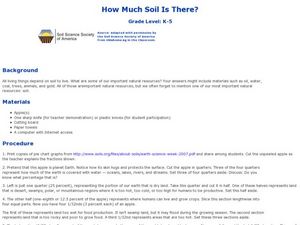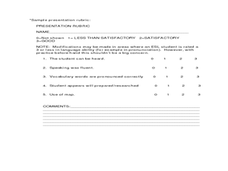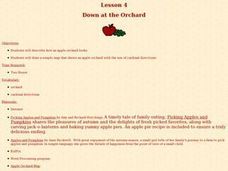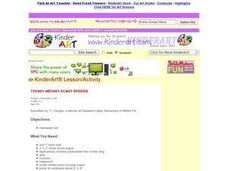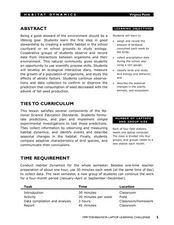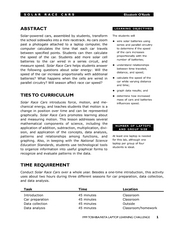Curated OER
How Much Soil is There?
Young scholars examine that all living things depend on soil to live. In this science lesson, students pretend that an apple is planet Earth. Young scholars cut the apple to represent the portions of Earth with the last section...
Curated OER
Butterfly Life Cycle
Second graders explore biology. In this life cycle instructional activity, 2nd graders act out the stages a caterpillar goes through to become a butterfly. They spend days prior to this instructional activity observing caterpillars they...
Curated OER
Properties of the Ocean: Change
Learners research and create a visual presentation on the seasonal salinity of the Earth's oceans. They apply the research in a simulation of a lab disaster in which they must relabel ocean samples.
Curated OER
Diversity of Trees
Fourth graders explore the uses of trees, In this trees lesson, 4th graders discover the uses of trees and how we use them everyday. Students collect items and decide if they are made from trees, have a scavenger hunt for wood products...
Curated OER
Long Island Sound
Students use the Internet to research the history of Long Island Sound. In groups, they identify the sources of point and nonpoint pollution and how humans are impacting the area. After watching a video, they discuss the role of...
Curated OER
Places in My World
Second graders explore where they are located on the globe. In this maps and globes lesson, 2nd graders use a map to show where they live and show the cardinal directions. Students identify characteristics of mountains, flat land,...
Curated OER
Down at the Orchard
First graders examine what an apple orchard looks like and work with cardinal directions. In this apple orchard and direction instructional activity, 1st graders listen to Anne Rockwell's, Apples and Pumpkins, and Amy and Richard...
Curated OER
Boom and Bust
Students investigate commercial fishery. In this fishery lesson, students describe stages in commercial fishery, interpret data and predict when a fisher stock is showing signs of overexploitation.
Curated OER
Labor Unions and Strikes
Teens explore economics by listening to a labor history lecture and an excerpt from Looking Backward, by Edward Bellamy. A detailed outline is provided for the lecture, along with follow up and assessment questions. In groups, they...
Curated OER
Great Expectations
Students examine proper care of cattle, their breeding seasons, and benefits to raising cattle. After reading and interpreting a chart containing information on gestation periods, students answer questions on a worksheet. They research...
Curated OER
Creative Position Word Center Activity
Students use positional words to describe the location of objects and demonstrate the ability to follow multi-step oral directions. Seasonal shapes are decorated in relation to the directions and positions stated by the positional word.
Curated OER
Teensy Weensy Scary Spiders
Students create "teensy weensy scary spiders" using foam balls, tissue paper, yarn, pipecleaner, scissors and glue in this Halloween art lesson for the early elementary classroom. It is suggested to begin the activity as a science...
Curated OER
Fall vs. Spring
Young scholars compare and contrast the seasons of fall and spring. In this fall and spring lesson plan, students learn the differences between fall and spring through books and pictures, identify the differences, draw their own...
Curated OER
Heavens Above
Middle schoolers study the stars and their positions. In this astronomy lesson students see how scientists can predict the positions of the stars and can tell how they would have appeared in the past.
Curated OER
Habitat Dynamics
Pupils develop an interactive diary to record bird seed consumption. In this habitat lesson, students predict and record the amount of birdseed eaten each week by birds.
Curated OER
Solar Race Cars
Students explore the relationship between time traveled, distance and speed. In this solar race car activity students wire solar batteries using series and parallel circuitry.
Curated OER
Sky 2: Shadows
students will explore making shadows and tracking the movement of an object over the course of a day to look for patterns. It is best to couple this shadow activity with reading the book, Bear Shadow, and making a map of Bear's...
Curated OER
Does More Wins Mean More Fans At The Ballpark?
Students, after getting information from the past baseball season off the Internet, calculate an attendance-to-win ratio for each of the 28 major league teams and then study the results to see if winning always leads to good attendance.
Curated OER
Water 1: Water and Ice
Students explore forms that water can take and examine the water cycle. In this hands-on science lesson, students participate in activities that require them to change water to a solid and back to a liquid again.
Curated OER
Water and Ice
Students explore water and ice. In this 3 states of matter lesson, students work with a partner to observe, illustrate, and describe the characteristics of an ice cube in a cup. The ice cube is observed again in 15 minutes and changes...
Curated OER
Water and Ice
Students study the liquid and solid states of water. In this water states lesson, students complete three experiments to study water as it cycles from a liquid state to a solid state and back. Students finish with a Venn Diagram...
Curated OER
Water 1: Water and Ice
Students explore forms that water can take. In this science lesson, students participate in hands-on activities that require them to change water to a solid and back to a liquid again.
Curated OER
Sky 2: Shadows
Students explore space science by participating in a shadow experiment. In this sky observation lesson, students identify how the sun creates different sized shadows by moving across the horizon. Students utilize yard sticks, markers,...
Curated OER
Mosaic Heart
Students create "Mosaic Hearts" in this adaptable art instructional activity using some old magazines, construction paper, and glue. The instructional activity includes examples of finished hearts and a materials list. Ideal for a...


